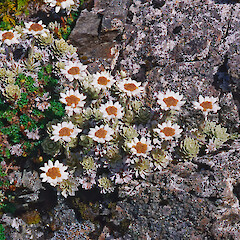Leucogenes leontopodium
Common name
North Island edelweiss
Synonyms
Helichrysum leontopodium Hook.f., Gnaphalium colensoi Hook.f.
Family
Asteraceae
Flora category
Vascular – Native
Endemic taxon
Yes
Endemic genus
Yes
Endemic family
No
Structural class
Herbs - Dicotyledonous composites
NVS code
The National Vegetation Survey (NVS) Databank is a physical archive and electronic databank containing records of over 94,000 vegetation survey plots - including data from over 19,000 permanent plots. NVS maintains a standard set of species code abbreviations that correspond to standard scientific plant names from the Ngä Tipu o Aotearoa - New Zealand Plants database.
LEULEO
Chromosome number
2n = 28
Current conservation status
The conservation status of all known New Zealand vascular plant taxa at the rank of species and below were reassessed in 2017 using the New Zealand Threat Classification System (NZTCS) – more information about this can be found on the NZTCS website. This report includes a statistical summary and brief notes on changes since 2012 and replaces all previous NZTCS lists for vascular plants.
Please note, threat classifications are often suggested by authors when publications fall between NZTCS assessment periods – an interim threat classification status has not been assessed by the NZTCS panel.
- Conservation status of New Zealand indigenous vascular plants, 2017 . 2018. Peter J. de Lange, Jeremy R. Rolfe, John W. Barkla, Shannel P. Courtney, Paul D. Champion, Leon R. Perrie, Sarah M. Beadel, Kerry A. Ford, Ilse Breitwieser, Ines Schönberger, Rowan Hindmarsh-Walls, Peter B. Heenan and Kate Ladley. Department of Conservation. Source: NZTCS and licensed by DOC for reuse under the Creative Commons Attribution 4.0 International licence.
2017 | Not Threatened
Previous conservation statuses
2012 | Not Threatened
2009 | Not Threatened
2004 | Not Threatened
Distribution
Endemic. New Zealand: North Island (from Mt Hikurangi and the Central Volcanic Plateau south to the Tararua Ranges), and in the South Island (Richmond Range)
Habitat
Subalpine to alpine. On rock outcrops, cliff faces, and crevices. Usually in sites free of much surrounding vegetation.
Detailed description
Stock stout, woody; stems much-branched, decumbent, woody at base; branchlets ascending. Leaves sessile, 8-20 × 4-5 mm, 3-5-nerved at base, linear- to lanceolate-oblong, acute to subacute, clad on both surfaces in silvery-white to yellowish, shining, appressed tomentum; basal leaves crowded in subrosettes, cauline densely imbricate to rather distant. Peduncles up to 100 mm long, clad in appressed foliaceous bracts. Capitula 8-15, congested into dense glomerules up to 25 mm diameter, subtended by up to 20 densely woolly lvs up to 20 mm long, forming a conspicuous white ray. Involucral bracts linear-lanceolate, c.5 mm. long, scarious with basal stiffening, toothed and ciliate towards acute apex, ± woolly on back towards tip. Achenes c.1 mm. long, pappus-hairs c.4 mm long
Similar taxa
Distinguished from Leucogenes grandiceps (Hook.f.) Beauverd by the more compact growth habit; by the basal leaves crowded into sub-rosettes; by the larger leaves (8-20 cf. 5-10 mm long) with acute to subacute leaf apices rather than obtuse (rarely apiculate); and by the leaves of the ray up to 20 mm long. Distinguished from L. neglecta Molloy and L. tarahaoa Molloy by its diploid (2n = 28), rather than tetraploid (2n = 56, L. neglecta) or octoploid (2n = 112) chromosome number. Leucogenes neglecta further differs from L. leontopodium by its long thin stems, narrowly elliptic acute leaves and floral bracts, and uniform silvery-blue colour, while L. tarahaoa differs by its compact, cushion forming habit, and silvery white leaves.
Flowering
November - March
Flower colours
White, Yellow
Fruiting
January - April
Life cycle
Pappate cypselae are wind dispersed (Thorsen et al., 2009).
Propagation technique
Easily grown from cuttings and fresh seed. Excellent in a pot within an alpine house, and in non-humid climates can be grown in rock gardens. Provided the root stock is kept cool can be grown in most lowland situations.
Etymology
leucogenes: White genus
Where To Buy
Occasionally available from specialist native plant nurseries.
Attribution
Description modified from Allan (1961)
References and further reading
Allan, H.H. 1961: Flora of New Zealand. Vol. I. Government Printer, Wellington.
Thorsen, M. J.; Dickinson, K. J. M.; Seddon, P. J. 2009. Seed dispersal systems in the New Zealand flora. Perspectives in Plant Ecology, Evolution and Systematics 11: 285-309













